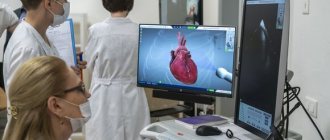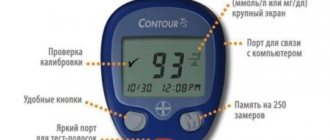Elevated blood sugar, or hyperglycemia, occurs for a variety of reasons. Normally, the sugar level should not be higher than 5.5 mmol/l. The severity of hyperglycemia is determined by two main factors: the total amount of glucose in the blood and the rate at which it increases. In medical practice, the pathological condition in question is classified according to two criteria: fasting hyperglycemia and afternoon hyperglycemia.
Glucose is necessary for the cells of the human body, but if its level exceeds the norm, this can lead to irreversible consequences. The person himself may not notice the symptoms of this condition for a long time if it is mild. If the sugar level is significantly elevated, characteristic signs appear that are important to recognize in time and consult a doctor. In our clinic you can always get advice from competent specialists, take the necessary tests and undergo a course of treatment.
Causes of high blood sugar
High blood sugar may be associated with certain diseases:
- diabetes mellitus and other endocrine pathologies;
- liver diseases;
- dysfunction of the pancreas;
- severe infectious diseases;
- obesity.
Diabetes mellitus is considered the most common cause of hyperglycemia, which is long-lasting and negatively affects almost all internal organs and systems of the body.
Factors that contribute to hyperglycemia that are not associated with pathologies of the body are also identified:
- overeating, predominance of simple carbohydrates in the diet;
- stress;
- severe premenstrual syndrome in women;
- alcohol abuse;
- hereditary predisposition.
Causes of diabetes
The reasons for the development of types 1 and 2 diabetes in patients are different. The disease of the first type is detected in young patients under thirty years of age. Impaired insulin production occurs when the pancreas is damaged by autoimmune origin. When it occurs, the destruction of insulin-producing ß-cells occurs.
In most patients, this pathology occurs after a viral infection. Most often, mumps, rubella measles, and viral hepatitis. This pathological condition can also develop after toxic effects on the body by the following substances: nitrosamine, pesticides, and some medications.
These substances contribute to disruption of the immune response and the occurrence of autoimmune reactions. The impact of altered immune cells on the islets of Langerhans of the pancreas causes their death. Due to this, insulin production decreases. This condition develops when more than 80% of these cells are affected.
In the second type of disease, all cells become insensitive to insulin. Plasma insulin levels are normal or elevated, but the cells do not perceive it. The majority of such patients have diabetes. Glucose tolerance occurs for the following reasons:
- Genetic predisposition. Such patients have relatives with diabetes. If both parents suffer from it, the likelihood of inheriting a predisposition to it increases to 70%.
- Obesity. With a large amount of adipose tissue in the body, their sensitivity to insulin decreases.
- Poor nutrition. With a predominance of simple carbohydrates in food and a lack of fiber, the risk of developing diabetes mellitus increases.
- Cardiovascular pathology. Severe forms of these diseases - atherosclerosis, ischemic heart disease, arterial hypertension lead to increased tissue insulin resistance.
- Chronic stress. In this condition, the level of catecholamines and glucocorticoids increases. This contributes to the development of diabetes.
- Taking certain medications. The group of drugs that increase the risk of diabetes includes: synthetic glucocorticoids, diuretics, some antihypertensive drugs, cytostatics.
- Chronic insufficiency of the adrenal cortex. This disease increases the risk of developing tissue insulin resistance.
As a result, the penetration of glucose into cells decreases and its level in the blood increases.
Associated symptoms
A pronounced increase in blood sugar levels manifests itself with characteristic symptoms, which are especially clearly visible in patients with diabetes:
- constant thirst and dry mouth;
- increased urge to urinate;
- dizziness;
- headache;
- increased appetite, weight gain or sudden weight loss (this symptom is typical mainly for patients with type 1 diabetes);
- skin itching, furunculosis, prolonged wound healing;
- increased blood pressure due to impaired renal function;
- increased irritability;
- drowsiness;
- apathetic state;
- difficulty concentrating;
- decreased vision;
- susceptibility to infectious diseases.
Having noticed such manifestations in yourself, you may suspect hyperglycemia, but only a qualified doctor will make an accurate diagnosis. In our clinic you can undergo a full range of examinations to identify acute and chronic diseases. An experienced endocrinologist will develop effective treatment tactics to eliminate pathological symptoms and return you to good health.
Complications of diabetes
There are acute and chronic complications of the disease. Acute complications develop quickly and require emergency hospitalization. These include the following conditions:
- Hypoglycemia. In this condition, glucose levels are sharply reduced. It occurs when there is an overdose of insulin, untimely food intake, or physical stress. The patient experiences hunger, a feeling of trembling in his hands, dizziness, sweating, and aggression. Then consciousness is impaired.
- Ketoacidosis. It causes glucose levels to rise. It does not enter the cells and accumulates in the blood. The condition is manifested by decreased appetite, dry skin, and thirst. The patient smells of acetone. Confusion and drowsiness appear.
- Hyperosmolar coma. It is characterized by an increase in blood glucose with general dehydration of the body.
- Lactate acidotic coma. The condition occurs in the elderly in the presence of disorders of the respiratory and cardiovascular systems due to oxygen starvation.
Patients with signs of these pathological conditions require immediate medical attention.
In late complications, damage to the vascular and nervous systems is observed. Diabetic angiopathy is massive vascular damage. It applies to vessels of any caliber. Microangiopathies cause the appearance of diabetic nephropathy and retinopathy. Macroangiopathy affects the vessels of the heart, brain and arteries of the lower extremities.
Diagnostics in our clinic
Diagnosis of hyperglycemia includes taking a medical history, analyzing clinical symptoms and a number of laboratory tests. A blood sugar test is taken in the morning on an empty stomach. In some cases, it becomes necessary to repeat the analysis after a few days to exclude possible stress factors.
In modern medicine, several methods of testing blood for sugar are used:
- rapid test for determining the approximate glucose concentration - can be carried out at home, but does not provide one hundred percent accuracy;
- analysis for glycated hemoglobin - allows you to determine the average glucose level over a certain period of time (1-3 months);
- Glucose tolerance test is a comprehensive study that involves taking blood from a finger prick four times over two hours (on an empty stomach and after taking glucose).
In a healthy person, the glucose level is 3.5-5.5 mmol per liter of blood. An indicator of 6 mmol is considered a prediabetic state. If the glucose concentration exceeds this value, the doctor has reason to diagnose diabetes mellitus.
When performing a glucose tolerance test, a result of up to 7.9 mmol/l is considered as normal. Diabetes mellitus is indicated by a value of over 11 mmol per liter.
Principles of treatment
If you have high blood sugar, you will need treatment to avoid life-threatening conditions. The complex of therapeutic measures includes:
- adherence to the principles of proper nutrition;
- regular monitoring of blood sugar levels - for this you can purchase a special device for home use - a glucometer. It is recommended to carry out the test several times a day. Urgent consultation with an endocrinologist is required if sugar levels increase repeatedly over a short period;
- regular physical activity;
- weight normalization;
- regular monitoring of blood pressure and cholesterol levels;
- taking medications to reduce blood glucose concentrations (insulin secretagogues, alpha-glucosiade inhibitors, etc.).
Treatment tactics are always selected individually depending on the reasons that led to the increase in blood sugar.
Diabetes mellitus in children - symptoms and treatment
Complications of diabetes mellitus in children are divided into acute and delayed.
Acute complications are associated with an unstable course of diabetes mellitus and a sharp decompensation of carbohydrate metabolism. This can happen at any stage of the disease due to stress, poor diet or treatment tactics, acute, chronic infections or other concomitant diseases.
The fact is that children and adolescents often face psychological problems regarding their illness, especially type 1 diabetes. Because of this, they may deliberately break their diet or stop taking insulin, unaware of other serious problems that may occur. The result is either hypoglycemia with the possible development of hypoglycemic coma, or significant hyperglycemia with diabetic ketoacidosis or hyperglycemic hyperosmolar status.
Hypoglycemia is the most common complication of type 1 diabetes. In the case of type 2 diabetes, it may occur when insulin therapy or treatment with sulfonylurea derivatives is necessary.
Children, especially at an early age, are more sensitive to low blood glucose levels than adults, so they are at higher risk of developing hypoglycemia. In this case, symptoms appear against the background of higher glucose levels compared to adults, and the rate of development of severe hypoglycemia, requiring urgent intervention, is higher [1].
Hypoglycemia in children can manifest itself as tremors, tachycardia, and increased sweating. Sometimes the symptoms of neuroglycopenia come to the fore: headache, drowsiness and impaired concentration. Young children with hypoglycemia may notice behavior changes such as angry outbursts, restlessness, irritability, or apathy.
Diabetic ketoacidosis occurs against the background of hyperglycemia due to a lack of insulin or increased concentrations of counter-insulin hormones. Diabetes mellitus is often first diagnosed in this condition: in 88% of children with type 1 diabetes and 10% of children with type 2 diabetes [1][12].
The complication begins in different ways: from a mild course with minor dehydration to a severe course with serious dehydration and loss of consciousness.
Symptoms of diabetic ketoacidosis include dry skin, increased thirst, tachycardia, rapid breathing or Kussmaul breathing - rare, deep, with noisy inhalation and sharp exhalation, the smell of acetone on the breath, nausea, vomiting, abdominal pain, confusion or loss of consciousness.
Laboratory signs include:
- blood glucose level is more than 11 mmol/l;
- increased concentration of ketone bodies in the blood and urine;
- pH level is less than 7.3;
- bicarbonate level is less than 15 mmol/l [1][2][7].
Hyperglycemic hyperosmolar status can occur in neonatal diabetes mellitus, type 1 and type 2 diabetes. Manifested by convulsions, aggression, loss of consciousness.
Laboratory signs include:
- blood glucose level from 33 mmol/l and above;
- a slight increase in the concentration of ketone bodies in the blood and urine;
- pH level below 7.3;
- bicarbonate level is below 15 mmol/l [1][2][7].
Long-term complications of diabetes begin in childhood but may appear later in adulthood. Such complications include diabetic polyneuropathy, retinopathy and nephropathy.
Diabetic polyneuropathy is associated with damage to peripheral and autonomic nerves [14]. It occurs due to metabolic disorders and damage to small vessels - microangiopathy.
Neuropathy is the most common delayed complication in children with diabetes. At this age, it is usually in the preclinical or primary clinical stage.
With peripheral neuropathy, the lower extremities are most often affected. This may cause numbness, tingling, burning in the fingers and toes, and short-term cramps. Even light touches can cause discomfort or pain.
Damage to the autonomic nerves disrupts the functioning of internal organs: the heart, gastrointestinal tract, urogenital system, etc. Therefore, the symptoms of autonomic polyneuropathy are numerous and varied. They depend on which organ the affected nerve fibers are responsible for innervating. The child may be bothered by tachycardia at rest, decreased blood pressure when changing body position, heartburn, stomach pain, difficulty urinating, etc.
Diabetic retinopathy is associated with damage to the retinal vessels. It can appear in children within a year after the onset of the disease, and sometimes only with insulin resistance.
In the initial stages, the complication does not manifest itself in any way. As the disease progresses, the child may have complaints of deteriorating vision, the appearance of “spots”, dots or veils before the eyes, difficulty reading, and sometimes pain in the eyes after visual stress.
In 4% of children, diabetic retinopathy leads to blindness within 3-5 years [22]. Severe retinopathy with vision loss develops more often in adolescents than in adults [1].
Diabetic nephropathy , which occurs during childhood or adolescence, is a leading cause of disability and death in adult patients with diabetes. In children, this complication is usually in the preclinical stage, so doctors often underestimate the presence of this problem.
Preclinical diabetic nephropathy can be identified by regularly checking laboratory parameters that may indicate diabetic kidney damage. These indicators include the level of albumin and creatinine, glomerular filtration rate, etc. For example, incipient nephropathy in children and adolescents is manifested by microalbuminuria - when the level of albumin in morning urine is 30-300 mg/l.
In addition to polyneuropathy, retinopathy and nephropathy associated with damage to small vessels, children develop initial manifestations of macroangiopathies , such as atherosclerosis of the coronary arteries. Most often, such complications are associated with poor control of blood glucose levels.
Despite the fact that symptoms of delayed complications rarely appear in childhood, functional impairment begins at this time. The risk of complications increases with puberty. During this period, the child undergoes endocrine changes, the level of growth hormone and sex hormones increases. As a result, insulin sensitivity decreases and insulin resistance occurs. In addition, growth hormone is a counter-insular hormone, so the need for insulin in adolescents increases significantly and can reach up to 2 U/kg [23].











